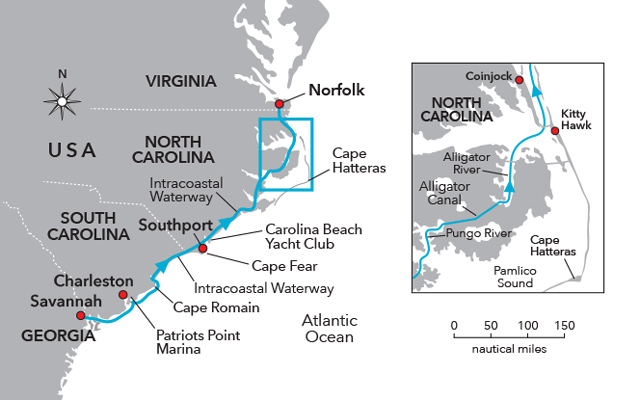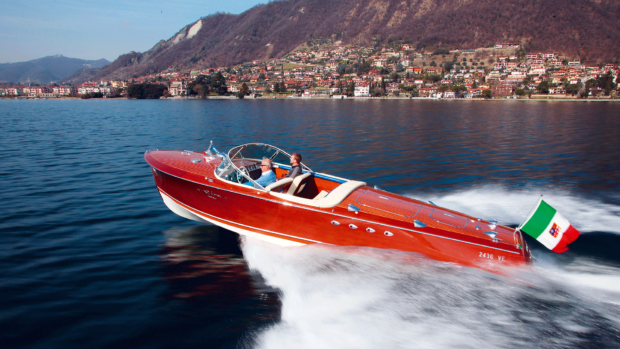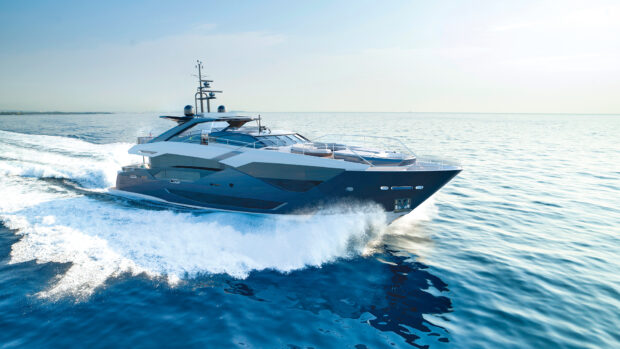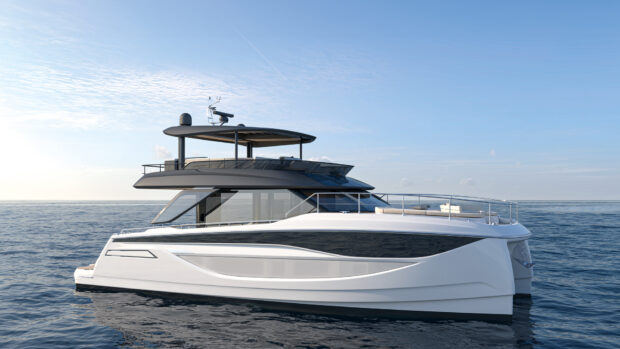Princess V48 owner Elliott Maurice battles steering issues, notorious reefs, dangerous reptiles and the might of the US Navy to visit some of the East Coast’s most historic harbours en route to New York and the Great Lakes.
This is Part 3 of our Cruising the Great Loop series, make sure to read Part 1 and Part 2 first.
Commencing a 115nm leg of a 2,500nm cruise with mechanical issues is never a desirable option, particularly across open ocean. Our only hope of reprieve is a respected outfit of marine engineers kindly recommended by Fairline after a call to a friend who works for the brand.
An electronics specialist, a plumber and a mechanic are awaiting our arrival in Charleston. But first we have to get there. As the British navy’s former gateway to the Caribbean and the northern end of the Bermuda Triangle, we’d planned to spend three days in Charleston so at least we had time on our side.
Article continues below…

Hemingway’s boat reborn: How Pilar was recreated in meticulous detail

Biggest sportsfish yacht: 52m aluminium whopper takes shape at Royal Huisman
Founded in the 1670s, it is steeped in history including, sadly, as a former centre of slavery. However, these days, it is one of the most beautiful and cultured cities in the US as well as the home of several legendary US warships. Our reservation at Patriots’ Point Marina offers the perfect base for our stay.
The leg from Savannah, Georgia, along the South Carolina coast involves a short route out of Ossobo inlet followed by a 100-mile open water stretch without any worrisome shoals, reefs or tides, finishing in the wide, safe confines of Charleston Harbor. With this in mind, an early start and thorough briefing about the importance of monitoring the engine temps and pressures were essential.
We’d made a temporary repair to the hole in the starboard engine’s exhaust but not before it had covered my lovely clean engine room in black soot! The risk of further overheating also meant restricting our speed to a lowly 22 knots for the five-hour ocean passage. At least the 2-3ft following sea should make it a relatively peaceful one.

Exclusive waterside homes in Savannah, Georgia
Sweet Carolina
We push off at around 7.30am, enjoying a gentle 6nm cruise out into the ocean before turning North towards Cape Hatteras and up the coast of South Carolina. The first three hours go as planned until, out of the blue, the engine management system shrieks out a warning signal. Low fuel pressure on the port engine.
I shut down the motor immediately and open the engine hatch to take a look. Having had numerous experience of dirty fuel in the Bahamas, I have an inkling of what it might be. But first I need to rule out the more worrying possibility of a leaking hose or fuel pump.
Large turbo diesels generate a lot of heat, so the engineroom is not my favourite place, especially on a hot day in the open ocean. Wrapping my arms in towels to avoid burns, I prostrate myself across the hot engine to get to the fuel pump on the far side of the Volvo D9.

Father-and- son crew mates Nick and James
Nothing seems awry, the fuel filters look clean and there is no sign of any leaks or failing joints. I conclude that a misreading fuel sensor is the most likely cause. In port it would be a 5-minute replacement using a spare I already have stowed away on board but trying to fix it out here is not a sensible option. We press onwards, albeit slowly at 12.5 knots. With 40 sea miles still to go, our passage time will take a lot longer, especially with the gulf stream current on our nose.
Over the next five hours the wind steadily increases to almost 30 knots kicking up a 4ft swell that tosses us about like a cork. With no autopilot to take the strain (it is malfunctioning too), we take 60-minute watches at the helm steering by hand. After what seems like an age, we finally turn due west into the Charleston Harbor inlet and limp down the 3-mile channel into port.
A radio call to Charleston Harbor Resort and Marina secures us a slip on the outer wall with fabulous views of Patriots Point, the USS Yorktown and across the river to old Charleston. But first we have to negotiate a 30mph cross wind blowing us onto the pontoon past a 60ft flybridge with its bow protruding.

The crew celebrate their safe arrival in Charleston
In these conditions a sickly engine is far from ideal. My only option is a stern-in approach into the wind and lots of power. Thankfully with four skilled crew members onboard, we complete the manoeuvre unscathed and our dignity intact. Once secure, we are treated to one of the most breathtaking sunsets I have ever witnessed as it slowly sinks behind the massive aircraft carrier turned museum, the USS Yorktown.
Culinary delights
Charleston is truly a wonderful city, with beautifully maintained buildings and an ambiance befitting its heritage. It also offers some of the best dining the east coast has to offer. The following morning, as promised, all three engineers turn up to sort out our various issues.
The guest cabin toilet, which has refused to draw water for the last two days, turns out to be nothing more than a closed seacock, which one of the crew mistakenly shut off during a bilge inspection. The wandering autopilot continues to baffle the electronics’ specialist but we can live with that. The engines, however, need proper attention.

Enjoying sunset cocktails in Privilege’s cockpit
The low fuel pressure is being caused by a blockage in the fuel line between the primary and secondary filters, requiring it to be removed, blown through and replaced along with two new fuel filters. The air filters also needed changing as the old ones are full of black soot from the leak. The T-clamp needed to plug the leak proves harder to find but we track one down in Annapolis and arrange overnight shipping to Charleston. By mid-afternoon I am finally able to relax with the rest of the crew at the resort’s pool.
For the remaining two days of our visit, we make the most of what Charleston has to offer, including a fascinating tour of the USS Yorktown and the historic old town with its beautiful but often sad reminders of America’s struggles through the 19th century.
Highlights include smoking a Cuban cigar in an Airstream caravan converted to a cigar lounge, an epic meal of Kobe beef fillet with truffled mash and a cocktail bar serving the best Manhattans I’ve ever had.

On the flight deck of USS Yorktown in Patriots Point, Charleston
Atlantic graveyard
However, this is a boat trip not a sabbatical and another crew member is due to join us in Norfolk VA. So before we know it we are back on board for the next leg, a three-day passage taking us past Cape Fear and inside Cape Hatteras to Norfolk, Virginia. This will be the most dangerous section of our journey as Cape Hatteras is where the Atlantic Gulf stream and Labrador current meet, stirring up intense and unpredictable weather.
It’s reputation as The Graveyard of the Atlantic is well deserved. Over 600 ships have perished here in the past 400 years and the local lifeboat and coast guard services are some of the busiest in the US. A careful weather watch and regular crew briefings will be essential. With over 400nm to cover and a weather window of three days before things turn nasty, we need to get a move on.
An early 6.30am start sees us departing Charleston. Our original route would have taken us on a direct ocean route to Cape Fear. However, we decide to reroute back into Winya Bay to pick up a safer intra-coastal passage for the rest of the journey, cutting our ocean passage from 140nm to 50nm or so.

With wind and sea state forecast to build throughout the day it feels the wiser choice, especially given the risk of further engine issues. The only other navigation concern is a notorious reef 5nm east- south-east of Cape Romaine that could tear us to pieces.
Most boaters taking on The Great Loop do so in sturdy trawler yachts and take months not weeks to cover the distance at displacement speed, taking the intracoastal route wherever possible. Our aim is to knock off the miles in a more speedy fashion using Privilege’s performance to shrink the distance.
Thankfully, we pass the Cape Romain shoal at low tide, its ship-killing rocks poking out through the breaking surf like rows of jagged teeth. I can’t imagine how 300 years ago unwieldy sailing ships using basic navigation managed to run these routes so efficiently.

A storm-damaged shrimping boat near Cape Fear
Even with our modern, agile craft the crew struggle to maintain a course as we are pushed and pulled all over the place. At the time we put it down to the Atlantic Gulf stream, but it’s another 24 hours before we find out the real reason.
Despite our struggles, we find our way into Southport without any drama for a very pleasant lunch stop of freshly caught crab and fish before continuing on past North Carolina’s snow-white beaches and fabulous waterfront homes. Arriving safely in Moorhead City Yacht Basin, I fall into conversation with the owner of a Princess S62, who took the more direct ocean route and confirms he had water over the flybridge on the latter stages of the passage.
The next day’s route involves a 70nm run across Pamlico Sound, a lagoon that runs from Moorhead to the Oregon inlet. An early morning weather warning makes me hesitant to follow this route so close to the treacherous outer banks, so yet again we reroute inshore up the Pungo River into the man-made Alligator Canal and Lake before passing Kitty Hawk and Coinjock straight into Norfolk, Virginia.
It is a safer option, albeit one without the luxury of cell phone coverage or rescue back-up from Sea Tow. Having taken on fuel, we set out on our new, slower 203nm passage. About an hour in, James calls out, “I’ve lost steering, the helm isn’t responding”.
“Stop the boat” I yell. Being in water as calm as a mill pond this is not an urgent safety concern but I need to find a solution. Turning the wheel hard to port and starboard confirms that it has completely failed. Our best option is to carry on to the nearest marina using the engines to steer where we can investigate it properly. Thankfully, Carolina Beach Yacht Club is only 2nm away.
Despite a rising wind we manage to manoeuvre Privilege onto a very exposed but accessible fuel pontoon. A quick call to the Princess dealer in the UK who sold me the boat four years ago soon has me speaking to one of their service managers even though it is Sunday.

Crewmember Makena in front of Privilege at Carolina Beach Yacht Club
After a handful of questions he soon diagnoses low steering fluid, which a simple refill and air pressure recharge should cure. He also talks me through a recalibration of the Volvo EDC throttle head which should resolve a minor throttle issue we’ve been having – a real credit to the customer service offered by Princess.
The local ship’s store has steering oil, which after a quick but messy refill through the steering column instantly brings our hydraulics back to life. It also explains the poor tracking we’ve experienced over the previous 500nm and the dodgy autopilot, which must have burnt out the pump as it tried in vain to keep a course.
These narrow stretches of the intracoastal seem to be a magnet for boating mishaps. During our two-hour enforced stopover we have watched a large Hatteras run aground and pull itself off again and been the victim of several dock-surfing experiences caused by inconsiderate boats passing too fast, too close.

On the Intra Coastal Waterway in South Carolina
Finally, despite a 30mph cross wind pinning us to the dock, a brand new Azimut 84, which has berthed behind us for fuel, ignores my offer of leaving within the next 10 minutes and thrusts his bow out to squeeze past us into the channel.
Predictably, I watch in slow motion as he gets blown straight back on to my starboard side, requiring all my crew to deploy roving fenders to keep him moving without removing the AWLGrip paint from both our flanks.
Four miles later, we pass the Azimut hard aground waiting for a tow, illustrating the unpredictable nature of the shifting sandbanks within the marked channels. I swiftly turn my attention to navigating this chaotic stretch of the Intracoastal.
Motor boat mayhem
As we proceed inshore, the landscape changes into the tree-lined and aptly named Alligator Canal where we soon spot several of these large reptiles hiding in mangroves along the banks. After 12nm we clear the canal and start running across a wide expanse of lake. Within minutes the wind changes direction and large storm clouds roll in, bringing wind and rain with them.
Now gusting well over 30mph, I catch sight of a 40ft sailing catamaran under power struggling to make headway with lightning and thunder flashing overhead. I radio him to ask if he needs assistance. He replies that he is struggling to turn into wind to drop anchor but is ok.
We keep watch until he is safely at anchor in the shallow marshlands. Shortly after the temperature plummets from 31°C to 15°C in a matter of minutes as a low-pressure cell follows the storm south. At least the wind now drops and the 4ft surge begins to subside.

Privilege is dwarfed by the vast warships in the Navy Yards at Norfolk, Virginia
The last part of the day involves a lock and a swing bridge before entering Norfolk via the Nanesond River. Just before sunset we emerge at the back end of Norfolk’s famous Navy Yards. As we sweep along the river at 22 knots we are greeted by mile after mile of US Navy hardware.
I have never seen so many fighting ships in my life, let alone in one place. They seem to go on for more than 5 miles. Having already felt the wrath of the US Navy’s protective stance towards their craft when we tried to get a closer look at one of its Trident submarines back in Georgia, I decide not to slow down to take in the spectacle.
So I’m surprised to see uniformed sailors pouring out onto the pontoon and waving at us as we pass one of its vast supercarriers. Fearing the worst, I look round to see Makena, our only female crew member, sitting on the aft sun pad, waving back with the stars and stripes flowing out behind her. Maybe if she had been onboard in Georgia, we could have got a closer look at that submarine after all!

Making good speed in Pungo River
At last light we pull into Tidewater Marina opposite the supercarrier and an ominous-looking stealth ship. On the other side of the river, the WW2 battleship USS Wisconsin is lit up resplendently against the night sky.
Seeing her 900ft hull bristling with heavy guns, I can understand the effect it must have instilled when it rolled into Tokyo harbour to accept the Japanese surrender on September 2, 1945. She is now a museum as well as a national monument.

It has been a momentous few days but we have made it safely to our designated rendezvous with another friend and crew for the next part of our adventure – inland past the mighty Potomac and into Annapolis before heading back out to sea towards New York and The Statue of Liberty.
First published in the October 2021 issue of MBY.
If you enjoyed this…
Be first to all the latest boats, gadgets, cruising ideas, buying advice and readers’ adventures with a subscription to Motor Boat & Yachting. Available in both print and digital formats, our monthly magazine will be sent directly to your home or device at a substantial discount to the usual cover price. See our latest offers and save at least 30% off the cover price.










